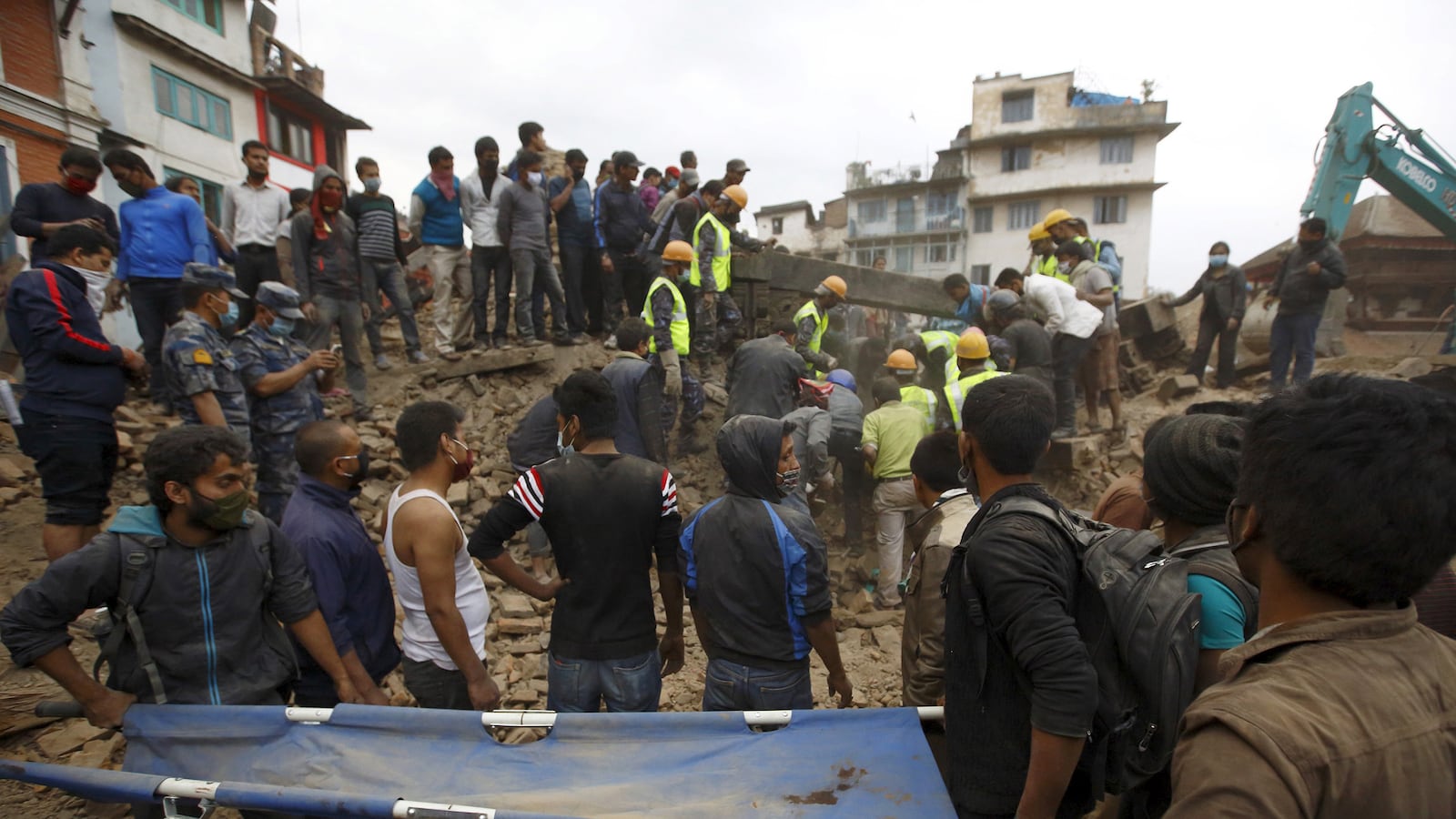KATHMANDU, Nepal — I was in the middle of Thamel, (Kathmandu’s unofficial pre-base camp for Himalayan trekkers and mountaineers), when the 7.8 earthquake struck on Saturday 25 April 2015.
It was almost noon.
Thamel is a warren of glorified alleyways hemmed in with cheap guesthouses, restaurants, travel agencies and shops of handicrafts catering to Western visitors. The three-and-four-story buildings lean out over the pavements and, when looking up, you see a fuliginous loom of electric and telephonic wires that, at every street corner, converge on one another like overpopulated beehives.
We—I and my assistant—were in the middle of one such lane heading north when suddenly several people shoved past us yelling, “earthquake.”
“New house!! New house!” my assistant screamed.
We darted into an empty doorframe that looked relatively new and grabbed each other tightly just as the brick building opposite came crashing down. We said nothing to each other. We were merely four legs conjoined and trying hard to adapt to the violent hula dance of the stone threshold beneath us. Throughout the shaking, there was the raining of debris and the percussive explosions created when shop owners dropped their iron storefront curtains. Were they thinking of looters even at that awful moment?
I should mention that I’m based in Los Angeles, no stranger to tremors, but this quake seemed hell-bent on destroying the world. And it was long. An impossibly long two minutes transpired before we could convince ourselves that the worst was over.
We were wrong. The next wave of terror came when people in the street got up off the ground and, like us, tried to think in which direction the nearest open space might be. It was a two-way stampede. We joined the northern current, evaded fallen power lines, got jostled by local women heedless of the drape of their saris, and dodged as best we could the cruel confetti of shattered glass.
At the next intersection a new tremor throttled the buildings around us and I believe that was when I experienced real panic. I remember staring at an abandoned motorcycle, lying on its side, and making calculations: We had not yet reached open ground and there was a good three minutes before we would reach the broad avenue going by Amrit Science College. The avenue was within view from where we stood and yet it telescoped away from us, as if unreachable given the obstacles—both human and architectural—barring our way.
But we did eventually reach it, just as a young Nepali man, bare-chested and grayish-white from dust, emerged from a mountain of crumbled brick and screamed at no one in particular, or perhaps he was screaming at the whole world. We hurried on.
We ran left at the avenue intersection and headed toward the west gate of Narayanhiti Palace. The absence of any sort of vehicle was unnerving. When we reached the palace, we turned northeast onto Lazimpat—one of the best roads in the city, widened during Maoist Baburam Bhattari’s brief stint as prime minister. I had dubbed it “Baburam Boulevard” but it didn’t feel like a cute quip during our exodus.
Despite the breadth of Baburam Boulevard, we were careful to remain in the middle of the street. We passed the military barracks to the left where soldiers and civilians alike were frantically digging through the remains of a demolished brick wall under which people were begging for help. Just then a third major tremor caused all the people on both sides of the street to race toward us, toward the center of the avenue.
I’m not quite sure what happened next. But it was about that time that I first noticed the high whine of sirens. Army vehicles, ambulances, police vans, and open-backed civilian trucks filled with injured people began to overtake us, adding to our own confusion even though we were witnessing (and thankful of what appeared to be) a very rapid response from the government. Presumably, these vehicles were speeding toward TUTH, the teaching hospital less than a kilometer away, just up the hill.
We finally reached Shangri-La, my hotel. Local people were funneling into the hotel parking lot—a safe haven from tumbling buildings. They were frantically trying, without success, to reach their loved ones on their smart phones. By then, helicopters were thrashing and zigzagging across the sky.
With each successive tremor, the vibrations became less punishing but somehow just as sickening: they were of a silent stirring nature that momentarily turned the ground to thick jelly. And we were the spoons.
***
More than forty-eight hours have transpired since the first harrowing quake. Things have calmed down in the city even as the real work and the true extent of the damage are just now coming into focus.
In the interim, I’ve experience so many bizarre Fellini-like moments.
Yesterday afternoon, I photographed an impromptu community camped in an open space in the Lainchaur area. Some of the homeless Nepalis exuded torpor or hopelessness or both, while others busied themselves in a kind of forced optimism, by being over-attentive to family members.
Afterward, I returned to my hotel. Upon entering the lobby, I decided to head down the corridor that leads to the garden in the back. The sun was low in the sky but earlier cloud coverage had departed. And this is what I saw: a large contingent of female Chinese tourists, who were gleefully showing each other how to properly wrap their recently purchased saris. They giggled and struck unconvincing “Indian” poses—chins extended, arms crooked upward. Their girlfriends snapped away with their iphones, making suggestions for newer, even more extravagant poses. Giddiness abounded while, down Baburam Boulevard, you could hear the sirens wailing.
Every time I check the local news the number of dead and injured rises steadily. There is a shortage of water, food, medical supplies and a severe lack of safe housing. People and their families have created tented camps in every park and plaza, including the huge Army Parade Ground in the middle of Kathmandu.
As I write this, it’s precisely 9:39pm April 27, 2015. A tremor just shook the hotel for three seconds. You learn to time these things. One thousand one, one thousand two, one thousand three. Done. Good. But the thumping returns—what I imagine would be the thump of a Chitwan deer’s heart just before the silent leopard swats its prey to the ground.
No time to think about all that. Let’s concentrate on the work ahead. The years of reparation ahead of us, long after the international press has moved on to the next country in pursuit of the next catastrophe.
India, Pakistan, Sri Lank, China, Turkey, Israel, Bangladesh, Poland, Australia, New Zealand and the United States have already arrived with their rescue teams and engineers. No doubt there are other nations that have landed. Good for them. International NGOs and NGOs like Doctors Without Borders have arrived. Good for them. There’s so much work to be done before the international donors eventually lose interest.
And what about the districts outside the Kathmandu Valley, where the worst destruction has taken place? Few TV units have visited these places. Too hard to get to, I suppose. They have covered the avalanche on Mount Everest, of course. That should be enough, right? That’s the sort of thing people really want to hear and read about.
A news media outfit asked me to write a piece for them, suggesting that I say something about the destruction and irretrievable loss of famous ancient buildings—how it will effect Nepal’s cultural climate. I asked my assistant, who’s young enough to be my son, what he thought about the possible cultural shift.
“Yeah,” he said. “Remember, in 2007, the temple in Durbar Square where we filmed the first anniversary rally celebrating Jana Andolan II? Now it’s gone. Gone. When I was a teenager, that’s where we used to take our girlfriends.”
At this very moment, who can think about cultural losses? The common grounds by the ghats are in use day and night now. The cremations are as unceremonious as they are endless.





